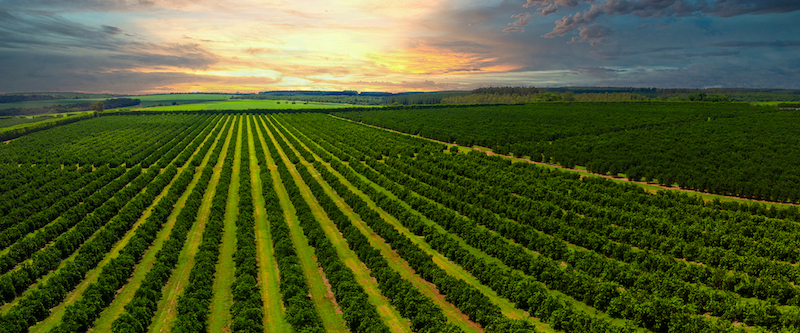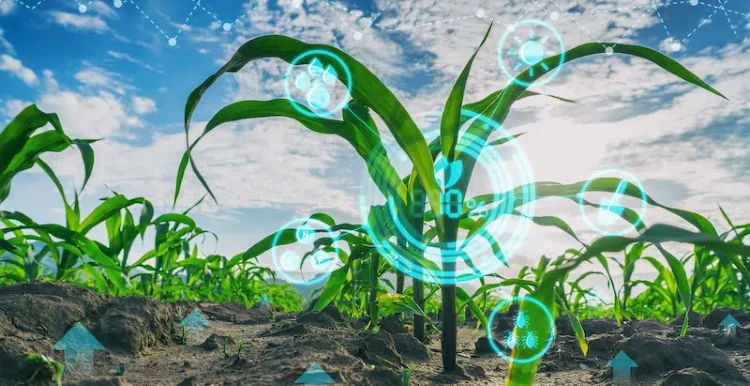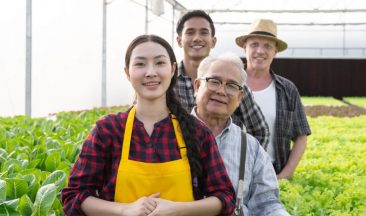In the last decade or more, traditional agriculture has faced renewed challenges. In most countries, the concept of growing crops for food has changed. The economics of modern production give advantage to larger operations and scale.
Smaller farming units found it increasingly difficult to maintain profitability, faced with a surge in inputs and equipment prices, as well as shortages of water and human resources.
Agriculture is transforming through the use of modern machinery, computerized tools, and information and communication technologies (ICTs) to improve decision-making and productivity.
The agriculture industry in the 21st century is reinventing itself, thanks to the availability of computer-driven technology and state-of-the-art equipment coupled with increased access to information and communication technology (ICT). Innovation in digital agriculture is driving the agricultural revolution of this century.
What is digital agriculture?
Digital agriculture is the integration of digital technologies and analytics to enable farmers, researchers, and other stakeholders to improve crop health and boost crop yields, reduce food loss and waste, optimize costs, reduce environmental footprint, and reduce long-term risk derived from factors such as weather patterns.
Information and communication technology (ICT) – an invaluable aid in modern farming.
ICT can be a vital tool in the hands of the modern farmer, allowing for a dramatic improvement in decision-making in real-time allowing for increased productivity while reducing costs and negative environmental impact.
In digital agriculture, weather data is fed into a centralized data pool and promotes farming decisions. Remote and proximal sensing is also used to capture invaluable soil and crop-related data through hyperspectral, multispectral, and thermal sensors or cameras.
The surge of digital agriculture has changed the face of growing vegetables in the field.
A typical scenario that has gradually faded into history with the advent of digital agriculture is that of the solitary tractor and driver wending their way slowly through the fields from dawn to dusk.
Here we will review some applications where digital agriculture allows increasing operations efficiencies: i) GPS systems; ii) UAVs; iii) remote sensing; iv) orchard management; v) greenhouse farming, and vi) robotic applications in agriculture., unoccupied GPS-controlled tractors are capable of around-the-clock operation, plowing, planting, and harvesting while at the same time gathering continuous georeferenced data that provide insights into crop development as well as tracking changes in health and maturity.
One of the more recent digital solutions for agriculture for information gathering is the deployment of unoccupied aerial vehicles (UAVs). This technology particularly lends itself to large-scale field crop cultivation.
UAVs can take care of all aspects of crop spraying, applying fertilizers, nutrients, herbicides, and pesticides in liquid format. Spraying from the air is faster and extremely accurate, making for efficiency levels that are much higher than any previous method.
How does remote sensing benefit on-farm and industrial productions?
Remote sensing crop cultivation is now used in digital agriculture in fields, orchards, and vineyard crop cultivation.
Tools available range from proximal sensors providing accurate information within a range of several square meters from the monitoring object. For large-scale projects, digital solutions for agriculture include drones that can cover hundreds of acres up to satellite imagery capable of covering hundreds of hectares.
Each of these remote sensing tools provides invaluable assessments of acreage covered, crop biomass, drought stress yield, phenological development, and vegetation vigor. This vital information provides digital solutions in agriculture by enabling early and efficient decision-making in irrigation, fertilization, and pest management for crop cultivation. Increased efficiency results in more sustainable practices, reduced excess production costs, and increased production now and in the future.

Digital agriculture in orchard management
Fruit cultivation has benefited greatly from the advances in digital agriculture.
Recently, research has demonstrated the applicability of remote sensing in orchard management. Information is used to process reams of data derived from various platforms.
The methods vary according to monitoring scale, visual assessment, sensor networks, unoccupied aerial vehicles (UAVs), and spectral satellite sensing (SSS).
All these methods can be utilized for data collection relating to specific orchard management activities (e.g., thinning assessment, spraying, disease detection, and yield estimation and prediction) throughout the whole fruit-trees growing cycle.
For many years, visual assessment was the only alternative for traditional growers. While this method was relatively accurate in theory, by nature, it was very tedious and limited in scope.
It is now accepted that remote sensing technology has become a significant factor in providing digital solutions for agriculture in modern orchard management, especially when it comes to data acquisition.
While conventional aerial and spectral satellite sensing has been applied in orchard management with acceptable results, they have mainly been ruled out due to their dependence on ideal weather conditions and the high costs involved.
Greenhouse farming and digital agriculture go hand in hand
One area of cultivation where digital agriculture leaves its particular mark is greenhouse farming – the cultivation of fruit, vegetables, and even flowers in a building specially constructed for the purpose, whose walls and roof are either glass or heavy Perspex.
The greenhouse interior is exposed to sunlight during all the daylight hours. The rays magnified by the glass or Perspex increase the levels of photosynthesis while protecting the plants from harsh weather conditions should they occur. Digital sensors control the temperature in the greenhouse, as well as irrigation cycles and integration of next-generation fertilizers and nutrients applied through a method known as micro-irrigation.
Micro-irrigation not only requires very little water but the cutting-edge technology used means that this increasingly scarce and valuable liquid can be recycled many times along with any additives through soilless irrigation.
Greenhouse farming has become one of the most valuable digital solutions for agricultural cultivation due to its proven ability to increase crop production dramatically by creating optimal climate conditions.
Plants are grown vertically instead of horizontally, making the returns per cubic meter higher than can ever be achieved in the open field.
You may be interested in:
The global move to sustainable agriculture
Agriculture Top Trends to Watch For in 2023
Agro-robotic will be a key factor for the future of digital-driven agriculture
Expanding the capabilities of robots from the lab and greenhouse environment to outdoor conditions is crucial to both digital agriculture and its sustainability when operating in harsh environments under challenging conditions.
The presence of AI will be particularly felt in greenhouse cultivation due to the controlled environment conditions and structured cultivation properties; there are already digital solutions in agriculture offering significant advantages, mainly for fruit harvesting. UAV platforms will manage several tasks, such as crop spraying and plant health inspections, as well as supervising ground robot fleets operating in the field.
Robotic systems to automate monotonous farm operations
Robotic systems provide several previously unrealizable digital solutions for agriculture, driven by the progress of ICT technologies, particularly artificial intelligence (AI).
The increasing demand for accurate field operations while reducing the farming inputs and environmental impact will demand combining robotic platforms with IA to eventually do away with the labor-intensive and expensive alternative of traditional farming equipment.
The presence of IA will be particularly felt in greenhouse cultivation due to the controlled environment conditions and structured cultivation properties; there are already digital solutions in agriculture offering significant advantages, mainly for fruit harvesting.
ICL and Digital Agriculture
At ICL we see ourselves as being dedicated to the advance of global food security.
Our tools focus on AgTech solutions, fertilizers, and other innovative products designed to reduce food waste while enhancing crop yields and quality. These e-learning tools and apps include information platforms and recommendations for farmers and professional agronomists, and more
Some of ICL’s innovative AgTech solutions include
- Agmatix: A unique platform that can be used for nutrient and trial management, as well as data acquisition, standardization, and integration into a unified database. Once standardized, Agmatix offers statistical and other advanced analytics tools to transform big data into powerful models and insights.
- Growers: an easy-to-use platform that connects farmers, advisors, and ag retailers to provide support for the ag retailer to conduct business with their farmer customers. This platform includes tools for managing relationships and communications, planning, planting, fertilizing, and treating growing fields.
- AngelaWeb 2.0: an online fertilizer recommendation tool to help farmers optimize crop quality and increase ROI by taking into account agronomic data of crops.
- Nutrient Deficiency Guide: an app that assists in recognizing nutrient deficiencies in planting conditions for a variety of crops.
- PeKacid advisor App: an app that helps you adjust the spraying water pH to the desired level to improve the efficiency of foliar applications.
- Polysulphate App: an e-learning app that provides a range of information about Polysulphate, a powerful and effective organic fertilizer with proven benefits for a wide range of crops.
We also teach members of the global farming community the important skills of assessing food loss and waste and enhancing their food supply while monitoring factors that influence biodiversity.
Summing up
Digital agriculture is developing in leaps and bounds, providing digital solutions for agriculture in remote sensing, artificial intelligence, and robotic systems.
Systems that will provide the modern farming community with digital solutions in agriculture to produce comprehensive, accurate, and transparent crop statistics-both at the national and regional levels, making for increased yield and quality.The drive to understand and adapt to the advantages that digital agriculture will bring is just getting underway. Many of the developing nations of the world still rely on traditional methods due to availability and cost. Digital solutions, like the ones previously mentioned, are becoming more accessible, affordable, and accurate, and will continue to transform the future of agriculture.




